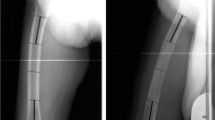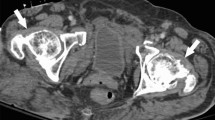Abstract
Purpose
To measure the femoral neck-shaft angle (NSA) on computed tomography (CT) images in femoracetabular impingement syndrome (FAIS) patients and explore its relationship with the anterior capsular thickness (ACT).
Methods
A retrospective review of prospectively collected data from 2022 was performed. Inclusion criteria included: primary hip surgery, 18 to 55 years of age, and CT imaging of the hips. Exclusion criteria included: revision hip surgery, mild or borderline hip dysplasia, hip synovitis, and incomplete radiographs and medical records. NSA was measured on CT imaging. ACT was measured using magnetic resonance imaging (MRI). Multiple linear regression was performed to assess the association between ACT and related variables, including age, sex, body mass index (BMI), lateral center–edge angle (LCEA), alpha angle, Beighton test score (BTS), and NSA.
Results
A total of 150 patients were included. The mean age, BMI, and NSA were 35.8 ± 11.2 years, 22.8 ± 3.5, and 129.4° ± 7.7°, respectively. Eighty-five (56.7%) patients were females. Multivariable regression analysis revealed that NSA (P = 0.002) and sex (P = 0.001) were significantly negatively correlated with ACT. Age, BMI, LCEA angle, alpha angle, and BTS were not correlated with ACT.
Conclusions
This study confirmed that NSA significantly predicts ACT. A decrease in the NSA by 1° increases the ACT by 0.24 mm.
Level of evidence
Level III.



Similar content being viewed by others
Explore related subjects
Discover the latest articles, news and stories from top researchers in related subjects.Data availability
The datasets used and/or analyzed during the current study are available from the corresponding author on reasonable request.
References
Bai H, Fu Y-Q, Ayeni OR, Yin Q-F (2023) The anterior hip capsule is thinner in dysplastic hips: a study comparing different young adult hip patients. Knee Surg Sports Traumatol Arthrosc 31(1):70–78
Bhimani R, Ashkani-Esfahani S, Mirochnik K, Lubberts B, DiGiovanni CW, Tanaka MJ (2022) Radiographic landmarks for the femoral attachment of the medial patellofemoral complex: a cadaveric study. Arthroscopy 38:2504–2510
Bizdikian AJ, Assi A, Bakouny Z, Yared F, Saghbini E, Bakhos GE et al (2018) Validity and reliability of different techniques of neck-shaft angle measurement. Clin Radiol 73:984.e981-984.e989
Boese CK, Dargel J, Oppermann J, Eysel P, Scheyerer MJ, Bredow J et al (2016) The femoral neck-shaft angle on plain radiographs: a systematic review. Skeletal Radiol 45:19–28
Curtis DM, Murray IR, Money AJ, Pullen WM, Safran MR (2022) Hip microinstability: understanding a newly defined hip pathology in young athletes. Arthroscopy 38:211–213
Devitt BM, Smith BN, Stapf R, Tacey M, O’Donnell JM (2017) Generalized joint hypermobility is predictive of hip capsular thickness. Orthop J Sports Med 5:2325967117701882
Gao G, Jiao C, Liu J, Zhou C, Liu Y, Ao Y et al (2022) Healing of joint capsule after hip arthroscopy using interportal capsulotomy and capsular closure influences clinical outcomes. J Orthop Surg Res 17:316
Haddad B, Hamdan M, Al Nawaiseh M, Aldowekat O, Alshrouf MA, Karam AM et al (2022) Femoral neck shaft angle measurement on plain radiography: is standing or supine radiograph a reliable template for the contralateral femur? BMC Musculoskelet Disord 23:1092
Hu Y, Ying H, Yu D, Mao Y, Yan M, Li H et al (2022) Positive correlation between the femur neck shaft and anteversion angles: a retrospective computed tomography analysis in patients with developmental dysplasia of the hip. J Arthroplasty 37:538–543
Kay J, Memon M, Rubin S, Simunovic N, Nho SJ, Belzile EL et al (2020) The dimensions of the hip capsule can be measured using magnetic resonance imaging and may have a role in arthroscopic planning. Knee Surg Sports Traumatol Arthrosc 28:1246–1261
Magerkurth O, Jacobson JA, Morag Y, Caoili E, Fessell D, Sekiya JK (2013) Capsular laxity of the hip: findings at magnetic resonance arthrography. Arthroscopy 29:1615–1622
Ng KCG, Jeffers JRT, Beaulé PE (2019) Hip joint capsular anatomy, mechanics, and surgical management. J Bone Joint Surg Am 101:2141–2151
Ng KCG, Lamontagne M, Adamczyk AP, Rakhra KS, Rahkra KS, Beaulé PE (2015) Patient-specific anatomical and functional parameters provide new insights into the pathomechanism of cam FAI. Clin Orthop Relat Res 473:1289–1296
Ng KCG, Mantovani G, Lamontagne M, Labrosse MR, Beaulé PE (2017) Increased hip stresses resulting from a cam deformity and decreased femoral neck-shaft angle during level walking. Clin Orthop Relat Res 475:998–1008
Rakhra KS, Bonura AA, Nairn R, Schweitzer ME, Kolanko NM, Beaule PE (2016) Is the hip capsule thicker in diseased hips? Bone Joint Res 5:586–593
Siebenrock KA, Steppacher SD, Haefeli PC, Schwab JM, Tannast M (2013) Valgus hip with high antetorsion causes pain through posterior extraarticular FAI. Clin Orthop Relat Res 471:3774–3780
Sun H, Huang H-J, Mamtimin M, Yang F, Duan Y-P, Zhang X et al (2022) Hip gluteus medius tears are associated with lower femoral neck-shaft angles and higher acetabular center-edge angles. Arthroscopy 38:1496–1505
Tahoun MF, Lizano-Díez X, Soler BC, Pons MT (2022) Superior outcomes after arthroscopic treatment of femoroacetabular impingement and labral tears with closed versus open capsule. Knee Surg Sports Traumatol Arthrosc. https://doi.org/10.1007/s00167-022-07266-y
van Klij P, Heijboer MP, Ginai AZ, Verhaar JAN, Waarsing JH, Agricola R (2021) Clinical and radiological hip parameters do not precede, but develop simultaneously with cam morphology: a 5-year follow-up study. Knee Surg Sports Traumatol Arthrosc 29:1401–1410
Weber AE, Kuhns BD, Cvetanovich GL, Lewis PB, Mather RC, Salata MJ et al (2017) Does the hip capsule remain closed after hip arthroscopy with routine capsular closure for femoroacetabular impingement? A magnetic resonance imaging analysis in symptomatic postoperative patients. Arthroscopy 33:108–115
Acknowledgements
This work was supported by Grants from the National Natural Science Foundation of China (Grant No.82072403, 81902205). We thank senior radiologist Yongye Chen and Zheng Wang for help in CT and MRI measurement.
Author information
Authors and Affiliations
Corresponding authors
Ethics declarations
Conflict of interest
The authors declare that they have no known competing financial interests or personal relationships that could have appeared to influence the work reported in this paper.
Ethical approval
The study was approved by the Ethics Committee of the Peking University Third Hospital (No. M2019193).
Additional information
Publisher's Note
Springer Nature remains neutral with regard to jurisdictional claims in published maps and institutional affiliations.
Rights and permissions
Springer Nature or its licensor (e.g. a society or other partner) holds exclusive rights to this article under a publishing agreement with the author(s) or other rightsholder(s); author self-archiving of the accepted manuscript version of this article is solely governed by the terms of such publishing agreement and applicable law.
About this article
Cite this article
Yang, F., Zhang, Z., Zhang, X. et al. Femoral neck-shaft angle can predict the anterior capsular thickness in patients with femoracetabular impingement syndrome. Knee Surg Sports Traumatol Arthrosc 31, 2716–2720 (2023). https://doi.org/10.1007/s00167-023-07347-6
Received:
Accepted:
Published:
Issue Date:
DOI: https://doi.org/10.1007/s00167-023-07347-6




